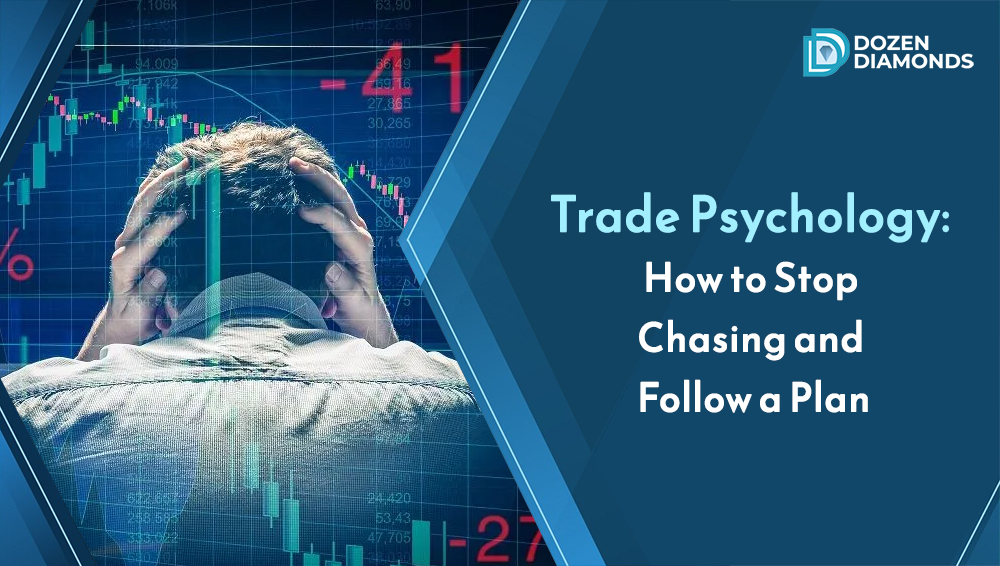Trade Psychology: How to Stop Chasing and Follow a Plan

Table of Contents
Introduction
By the end of this article, you will walk away with a repeatable system to stop chasing impulsive Trade Psychology and start following a structured, calm trading plan every single day.
Everything you will learn is backed by proven behavioral-finance research, cognitive-bias data, and performance analytics from thousands of retail traders.
Here are 3 outcomes you will gain:- A simple process to eliminate chasing behavior
- Daily routines to hard-wire discipline
- Journaling templates that build consistency
Understanding Trade Psychology
Trade psychology refers to how your emotions, impulses, biases, and mental habits influence your trading decisions.
It affects:- entry timing
- position sizing
- risk-taking
- exits
- revenge trading
- overtrading
Why Traders Chase Trades
Chasing happens when you enter a trade not because your plan says so — but because your emotions force you to jump in.
The four triggers are:- 1. FOMO
Fear of missing a rally. - 2. Recency bias
“What just happened will keep happening.” - 3. Loss aversion
Trying to “make back” losses immediately. - 4. Overconfidence
Winning trades create impulsive behavior.
The 7 Behavioral Traps That Make You Break Your Plan
1. The FOMO Trap
When price moves fast → instant emotional reaction.
2. The Confirmation Trap
You only look for signals that support what you want to do.
3. The Illusion-of-Control Trap
Believing you can predict short-term moves.
4. The “I’ll Fix It” Trap
Bad trades become “projects.”
5. The Overconfidence Trap
After a few wins, discipline disappears.
6. The “Market is Calling Me” Trap
Boredom creates overtrading.
7. The Shortcut Trap
Skipping rules “just this once,” leading to collapse.
To stop chasing, you must eliminate these behavioral triggers — not just the trades.
Daily Routines That Create Discipline
They fall to the level of their systems.
Morning Routine (5 minutes)
- Check your plan from previous night
- Confirm risk limits
- State aloud: “I trade the plan, not the feeling.”
Midday Routine (3 minutes)
- Pause
- Re-evaluate exposure
- Ask: “Am I chasing or following?”
End-of-Day Routine (7 minutes)
- Log all trades
- Rate emotional state from 1–10
- Note where you broke the plan
Journaling Templates That Keep You Accountable
Template 1: Entry Discipline
- Why am I entering?
- Does it match my plan?
- Risk per trade?
- Emotional state right now?
Template 2: Exit Logic
- Planned exit vs emotional exit
- Did I break structure? Why?
Template 3: Chasing Detection
- Did I enter without a signal?
- Was it because of FOMO, loss aversion, or boredom?
A single week of journaling transforms your trade psychology (focus keyphrase 3/4).
Cognitive Hacks to Rewire Your Trading Decisions
1. The 10-Second Breath Rule
Before entering a trade:- Take 10 seconds of slow breathing.
- This resets the amygdala.
2. The If-Then Rules
- “If price breaks support, then I exit.”
- “If RSI > 70, then no new entries.”
- This prevents emotional exceptions.
3. The 3-Trade Cap
- Max 3 trades per day.
- This stops the chase cycle completely.
4. The “Minimum Wait Time” Hack
- Wait 3 minutes after identifying a signal.
- If you’re still convinced, act.
- If not, it was emotion.
How to Build a Plan You Will Actually Follow
A trading plan must include:
1. Entry Rules
- Clear signals
- Indicator conditions
- Market structure setups
2. Exit Rules
- Targets
- Stop-loss levels
- Time-based exits
3. Risk Rules
- Max exposure
- Max number of trades
- Position sizing
4. Emotional Rules
- When to pause
- When to stop for the day
The plan isn’t the hard part.
Following it is.
That’s where STM solves the problem.
Why the Stressless Trading Method Fixes All These Issues
Every problem under trade psychology (focus keyphrase 4/4) is caused by emotion.
STM removes emotion entirely.
STM Helps You:
- Stop chasing
- Avoid overtrading
- Follow rules automatically
- Eliminate impulsive decisions
How STM Works
- Rule-based algorithm
- Automatic position sizing
- Automated exits
- No discretionary decisions
- Zero emotional interference
Conclusion — How Kosh App Makes Trade Psychology Easy
Trade psychology is not about “being disciplined.”
It is about removing the emotional loops that cause chasing, overtrading, and plan-breaking.
- You can use willpower.
- You can use routines.
- You can use journaling.
- But none of these compare to a system that enforces discipline automatically.
That system is:
- The Kosh App — built for rule-based consistency
- The Stressless Trading Method (STM) — built to eliminate emotional trading
- A white-box algorithm that helps you follow a plan without chasing ever again
Next Step
Download the Kosh App and activate STM today — follow a plan, not impulses.